02/05/2020
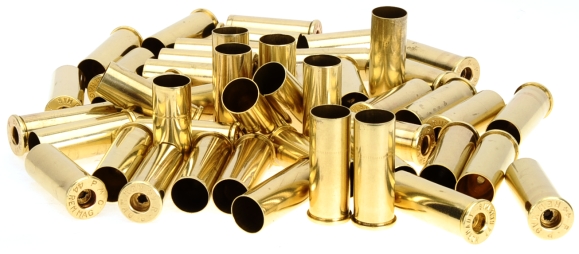
CarbineCarl949.6@instagoogle writes, “Joe, I know you are old, live in the woods and should be given a little leeway in deference to diminished mental acuity, but you’ve posted a picture of brass. That is definitely not a Ruger 77/44, so what’s up?”. Good eye there Sparky, you are absolutely right. The truth of the matter is, we are done taking pictures of and describing walnut, steel and poly pieces. It is time to noodle some handloads, make a lot of noise and collect some data.
As a side note, the shop’s steel pin cleaning equipment has been retired. It did an excellent job of cleaning, but left me picking steel pins out of my hair, food and bench top in the months that followed. So all of the stainless steel pins were melted down using more than a few stick matches, the molten steel was subjected to Cellini’s Wax Lips Process and cast into the form of a 1947 Buick Roadmaster bumper… which is now listed on eBay.
Current cleaning process? All brass is decapped and dumped into a heated sonic cleaner, with one liter of tap water and 25 milliliters of Hornady One Shot Sonic Clean cartridge case solution… or liquid dish washing detergent. Temperature of the bath is 40°C and sonic cleaning duration is 30 minutes. Brass is then thoroughly rinsed, dried and then dumped into a walnut medium filled vibratory cleaner for an hour. Finally, all brass is sorted by type and inspected.
The need to hurry up and slow down
There should be an objective here… but I am just sort of doggy paddling here for a bit. There is a need to extract the potential from the Ruger 77/44, so selecting bullets that favor this rifle and cartridge and typical applications would seem appropriate. Then there are those muzzle threads that could receive a silencer than would gobble up and diminish sound pressure so as not to scare wildlife into the next county with every shot. Of course, the Ruger’s bolt action suggests subsonic, heavy bullet handloads might yield interesting results. Sorry, lost in thought and forgot you were there…
I think I should begin without the distraction of a silencer or silencer related handloads and generate information that would have the broadest applications. Cast bullet loads are being omitted from the onset as they will not be useful in the silencer phase. Yeah. That’s it…

I do not know, at this juncture, if all of these will work OK with the Ruger 77/44. Some need case trimming below minimum SAAMI minimum case length to cycle through the rotary magazine maximum cartridge length of 1.695″, even though the rifle can handle a COL of 1.740″, but we’ll see.
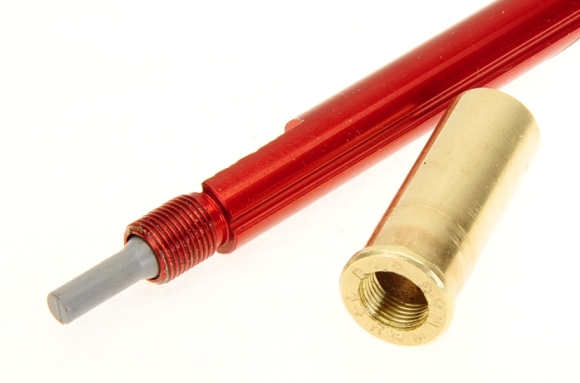
 Above – To assist in checking rifling clearance in the event single shot silenced performance ends up in the project, modified case for a Hornady COL gauge was made. The tap size is 5/16″-36, the metric drill is a short screw machine 7.20, the primer pocket was drilled out on a bench lathe. The tap/drill combination seems to yield the most durable threads.
Above – To assist in checking rifling clearance in the event single shot silenced performance ends up in the project, modified case for a Hornady COL gauge was made. The tap size is 5/16″-36, the metric drill is a short screw machine 7.20, the primer pocket was drilled out on a bench lathe. The tap/drill combination seems to yield the most durable threads.
Left – To facilitate case trimming with the Hornady Prep Center a #30 shell holder and #18 trimmer pilot were purchased. Those sizes are not supplied with the trimmer and corresponding pieces from other manufacturers won’t work with Hornady trimmers. The Hornady shell holder has a larger through hole that is used for case clamping and the pilot has a thicker shaft.
| Bullet | Bullet Type |
Weight Grains |
Bullet Length” |
Cannelure Height” |
Case Length” |
COL” |
| Sierra SportsMaster | JHP | 180 | 0.580 | 0.275 | 1.280 | 1.600 |
| Hornady | FTX | 225 | 0.855 | 0.465 | 1.255* | 1.645* |
| Remington | SJHP | 240 | 0.725 | 0.425 | 1.280 | 1.580 |
| Hornady | HP/XTP | 240 | 0.708 | 0.395 | 1.280 | 1.600 |
| Speer | JSP | 270 | 0.770 | 0.465 | 1.280 | 1.585 |
| Hornady | HP/XTP | 300 | 0.860 | 0.540 | 1.280 | 1.600 |
| Sierra SportsMaster | JSP | 300 | 0.890 | 0.450 | 1.160** | 1.600 |
| *1.255″ Hornady recommendation to accommodate long ogive. COL is over 1.610″ max COL spec **44 Special case used to accommodate long 300 grain bullet and stay inside 1.610″ SAAMI COL for subsonic loads. |
||||||
As previously noted, mechanically, the subject Ruger 77/44 chamber and free bore could accept an overall cartridge length with the 300 grain Sierra of 1.740″. The magazine, however, sets a maximum cartridge length of 1.695″. Neither extreme was required or offered performance potential.
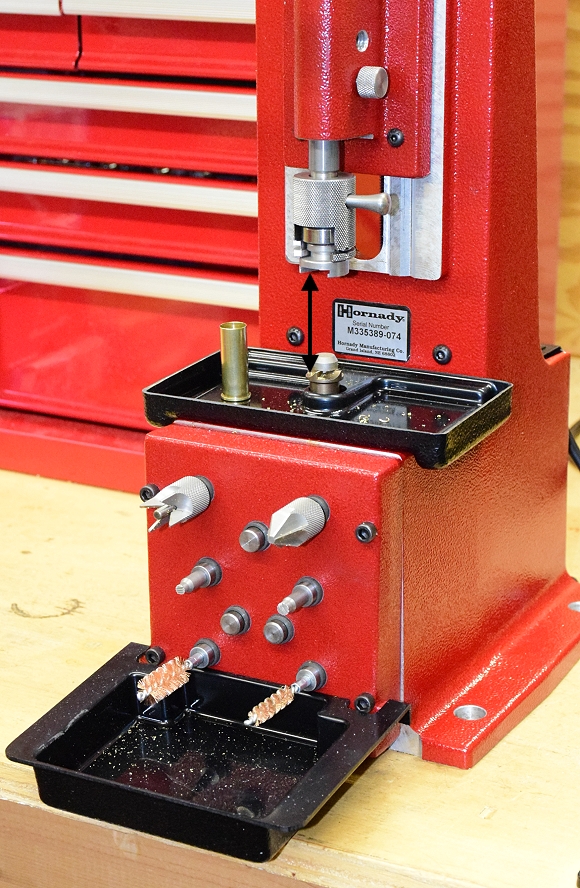
Cases assigned to Hornady FTX bullets were trimmed and assembled to Hornady’s recommendation. The easy way to set trim length is to adjust inside calipers to the desired case length and lock it in place, then place the jaws between the cutter and shell holder and adjust the trimmer to that spacing. A few seconds per case was all that was needed to trim and finish ream.
Copious notes…
The following may or may not be of consequence to you, but…
All ammunition was roll crimped. Not needed for the Ruger 77/44, but would be needed if the ammo was used on a revolver that held multiple rounds in a cylinder, each restrained at the rim.
Flat nose bullets were seated with a flat seater plug, round nose with a concave plug and a domed faced seater plug from an RCBS 357 SIG seater was used for the FTX. A flat face or shallow concave will flatten the tip or damage the surrounding metal. Hornady offers an FTX specific seater for their die sets.
Only the first two Sierra 180 grain loads resulted in a compressed charge, which I would attribute to the full length sizer die running on the tight side, Fired brass measured 0.455″ mid case. Sized brass measured 0.0448″, loaded compressed charged cases measured 0.450″. The max diameter spec for the 44 Rem Mag is 0.4569″ +0.0000/-0.0060″.
Large pistol magnum primers were used in all loads including subsonic 44 special loads.
Handloads
Warning: Bullet selections are specific, and loads are not valid with substitutions of different bullets of the same weight. Variations in bullet length will alter net case capacity, pressure and velocity. Primer selection is specific and primer types are not interchangeable. These are maximum loads in my firearms and may be excessive in others. All loads should be reduced by 5% as a starting point for development where cartridges have greater than 40 grains in capacity and 10% for cartridges with less than 40 grain capacity following safe handloading practices as represented in established mainstream reloading manuals. Presentation of these loads does not constitute a solicitation for their use, nor a recommendation.
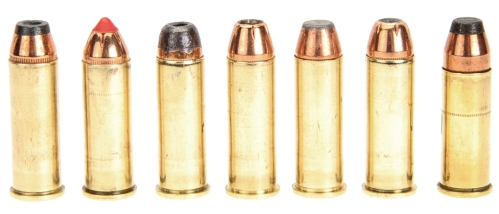
| 44 Remington Magnum 36,000 PSI MAP |
|
| Firearm | Ruger 77/44 |
| Barrel Length | 18.50″ |
| Max Case Length | 1.285″ +0.000″/-0.020″ |
| Min – Max COL | 1.535″ – 1.610″ |
| Primer | CCI 350 (LPM) |
| Bullet Diameter | 0.4320″ +0.000″/-0.0060″ |
| Reloading Dies | RCBS Carbide |
| Bullet Type | Bullet Weight Grains |
Net H2O Grains Capacity |
COL” | Powder Type | Powder Charge Grains |
Muzzle Velocity fps |
Muzzle Energy ft/lbs |
| Sierra SportsMaster JHP |
180 | 30.1 | 1.600 | Lil’ Gun | 31.5 | 2400 | 2303 |
| Sierra SportsMaster JHP | 180 | 30.1 | 1.600 | H110 | 31.5 | 2394 | 2291 |
| Sierra SportsMaster JHP | 180 | 30.1 | 1.600 | RS Enforcer | 27.0 | 2229 | 1986 |
| Hornady FTX* | 225 | 22.1 | 1.645 | H110 | 23.5 | 1908 | 1819 |
| Hornady FTX* | 225 | 22.1 | 1.645 | Lil’ Gun | 23.0 | 1983 | 1965 |
| Hornady FTX* | 225 | 22.1 | 1.645 | RS Enforcer | 20.5 | 1743 | 1518 |
| Remington SJHP | 240 | 24.0 | 1.580 | 300-MP | 25.0 | 1888 | 1900 |
| Remington SJHP | 240 | 24.0 | 1.580 | Lil’ Gun | 24.0 | 1984 | 2098 |
| Remington SJHP | 240 | 24.0 | 1.580 | RS Enforcer | 21.0 | 1744 | 1621 |
| Hornady HP/XTP | 240 | 26.4 | 1.600 | Alliant 2400 | 21.0 | 1845 | 1815 |
| Hornady HP/XTP | 240 | 26.4 | 1.600 | H110 | 26.0 | 1992 | 2115 |
| Hornady HP/XTP | 240 | 26.4 | 1.600 | Win 296 | 26.0 | 1953 | 2033 |
| Speer DCSP | 270 | 22.5 | 1.585 | Alliant 2400 | 18.5 | 1659 | 1650 |
| Speer DCSP | 270 | 22.5 | 1.585 | H110 | 23.5 | 1798 |
1939 |
| Speer DCSP | 270 | 22.5 | 1.585 | Lil’ Gun | 23.0 | 1864 | 2084 |
| Hornady HP/XTP | 300 | 19.8 | 1.600 | Alliant 2400 | 16.5 | 1458 | 1416 |
| Hornady HP/XTP | 300 | 19.8 | 1.600 | H110 | 20.0 | 1572 | 1647 |
| Hornady HP/XTP | 300 | 19.8 | 1.600 | Win 296 | 20.0 | 1569 | 1640 |
| Sierra SportsMaster** | 300 | 18.8 | 1.600 | Alliant 2400 | 12.5 | 1088 | 789 |
| Sierra SportsMaster** | 300 | 18.8 | 1.600 | Lil’ Gun | 13.0 | 1129 | 849 |
| Sierra SportsMaster** | 300 | 18.8 | 1.600 | IMR 4227 | 15.0 | 1096 | 800 |
| *Case trimmed to 1.255″ to accommodate FTX bullet and 1.645″ COL exceeds SAAMI spec. **Subsonic utilizing standard length 44 Special brass |
|||||||
Closing Part II and noting a coming Part III
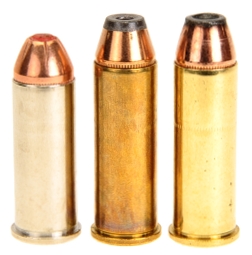 Left to right: Hornady 44 Special and Federal Power Shok and Federal Fusion 44 Rem Mag.
Left to right: Hornady 44 Special and Federal Power Shok and Federal Fusion 44 Rem Mag.
For the sake of context, three types of factory ammo was also shot from the Ruger: Federal Power Shok 180 grain rated at 1460 fps produced 2120 fps, Federal Fusion 240 grain rated at 1240 fps produced 1782 fps. Hornady 44 Special 165 grain FTX ammo rated at 900 fps produced 1292 fps.
The Ruger rifle manual and Ruger customer service indicated that only 44 Rem Mag ammo should be used in the Ruger 77/44. The reasoning behind the restriction is a concern that the short 44 Special case might rim lock in the rotary magazine and not something related to cartridge dimension and chamber. For folks who shoot rimmed cartridge in bolt action rifles, the approach is to always make sure the rim is in front of the previously inserted cartridge. With the rotary magazine, this was automatic. A considerable number of magazine’s full where shot without experiencing a problem which opened the door to a number of ammunition and handload options.
The Ruger produced between 1.5″ and 2.2″ 100 yard groups, with the exception of the 300 grain subsonic loads which were less accurate. While I liked the notion of a heavy subsonic bullet, the rifle’s 1:20″ rifling was not entertained by my experiment and, other than an academic exercise , it didn’t offer any unique benefit in other respects. The much simpler approach, at this point, seems to be 44 special loads loaded to cowboy action levels. We’ll see. I have some thoughts on improving accuracy and some good suggestions were offered by our friend George, so we’ll ring those out in Part III.
Ruger 77/44 shooting impressions
The Ruger is just a nice, compact rifle that is fun to shoot and, coupled with the 44 Rem Mag, it makes for an excellent combination for deer, hog, black bear combination. Report is moderate, recoil is modest and even just the metallic sights can get the job done. The light weight is appreciated, a little over five pounds, and an easy carry even in rough terrain. Factory ammunition and reloading components and equipment for the 44 Mag are readily available.
Fit and finish is very good. I am a walnut stock fan, but Ruger also offers synthetic stock versions. The Ruger 77/44 is particularly interesting for folks who also shoot a 44 Mag handgun. There is an economy of scale in higher production and a good way to gobble up the overhead cost of reloading gear.
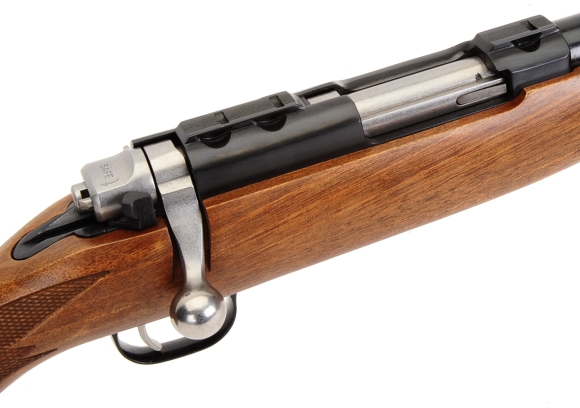

Email Notification